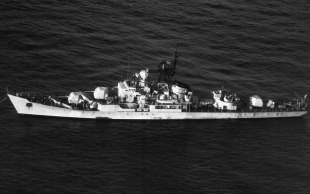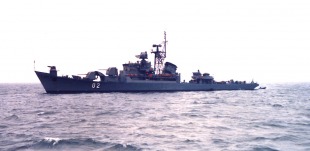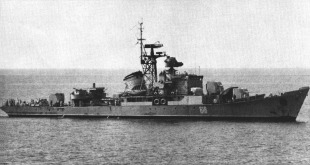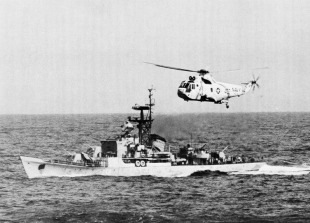Сторожевые корабли проекта 50
Основная информация
Главные размерения
Машина
- 2 * shaft steam turbines
- 2 * boilers
- 21,000 hp (16,000 kW)
Персонал
Боевые силы и средства
- 3 * 100 mm guns/56 (B-34) (3*1)
- 4 * 37 mm guns (2*2)
- 4 * 25 mm guns (2*2) — Some ships
- MBU 600 anti-submarine rocket launchers (replaced by two RBU 2500)
- 2 or 3 * 533 mm torpedo tubes (1*2 or 1*3)
The Riga class was the NATO reporting name for class of frigates built for the Soviet Navy in the 1950s. The Soviet designation for these ships was Storozhevoi Korabl (escort ship) Project 50 Gornostay (Ermine stoat). The Riga class was analogous to World War II era destroyer escorts.
A total of 68 ships were built by Nikolayev yards (20 ships), Komsomolsk na Amure (7 ships) and Kaliningrad (the lead yard 41 ships). Most ships were decommissioned by 1980, however some were sold to China. The programme was cut short by Nikita Khrushchev in 1956 as the ships were becoming obsolete and the last ship was completed in 1959.
Design
These ships were a smaller and simpler version of the Kola class. According to Conway's, this simpler group of ships were ordered by Joseph Stalin who was concerned about the cost of large ships. The class introduced high pressure steam turbines and new radars into Soviet service. The bridge, gun turrets, and magazines were covered in 8 mm (0.31 in)-thick armour. The main armament comprised three single dual-purpose 100 mm (3.9 in) guns with remote power control and a single Yakor type fire control director. The machinery comprised two TV-9 steam turbines with two boilers and had initial problems with reliability.
The Project 50 Riga class was a rather simplistic and straight forward design. With their basic capabilities, moderate size and ease of operation, they made perfect export vessels for smaller navies where such ships could easily fill the multi-purpose role, taking the place of large minesweepers and actual destroyers.
There was a modernisation programme designated Project 50 A in the late 1950s early 1960s. This included fitting anti-submarine rocket launchers (RBU-2500) new radar and adding permanent ballast for improved stability.
- Комментарии
 ru
ru en
en uk
uk




 Военно-морские силы Болгарии
Военно-морские силы Болгарии Фольксмарине
Фольксмарине Военно-Морской Флот СССР
Военно-Морской Флот СССР Военно-морской флот Народно-освободительной армии Китая
Военно-морской флот Народно-освободительной армии Китая Военно-морские силы Финляндии
Военно-морские силы Финляндии Военно-морские силы Индонезии
Военно-морские силы Индонезии Черноморский судостроительный завод
Черноморский судостроительный завод